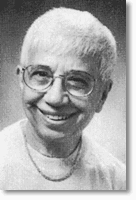 It was then that the communication professor
thought she'd better tune into a few of the programs, if only to
familiarize herself with the phenomenon that appeared to be a daytime
staple for a growing segment of viewers.
It was then that the communication professor
thought she'd better tune into a few of the programs, if only to
familiarize herself with the phenomenon that appeared to be a daytime
staple for a growing segment of viewers. 
Or their forerunners on radio, either.
But fate stepped in when Cassata was assigned to teach a mass communication course at the University at Buffalo in the mid-1970s.
 It was then that the communication professor
thought she'd better tune into a few of the programs, if only to
familiarize herself with the phenomenon that appeared to be a daytime
staple for a growing segment of viewers.
It was then that the communication professor
thought she'd better tune into a few of the programs, if only to
familiarize herself with the phenomenon that appeared to be a daytime
staple for a growing segment of viewers.
She got hooked on the shows and today confesses that she knows some of the on-screen characters better than she knows most of her real-life neighbors.
From Cassata's admittedly inauspicious foray into soap-o-rama, she has risen to become an authority on the genre.
William Bell, creator and director of "The Young and The Restless," believed to be the most popular of the daytime soap series, and Santa Monica, Calif.-based General Publishing Group commissioned Cassata and her former student Barbara Irwin, now a Canisius College faculty member, to write a book on the show. The photo-packed, 280-page "The Young and the Restless: Most Memorable Moments" was published last month.
In 1998, the duo again will team up to write a book celebrating the 25th anniversary of the series.
When soap operas debuted a half-century ago during radio's early years, those who stayed at home-especially mothers with young children and older women-were among the most frequent listeners of the serials.
The programs became known as "the soaps" because most were sponsored by companies that manufactured and sold soap products.
But many of radio's offerings like "Stella Dallas" and "Ma Perkins" gradually disappeared down the drain with the advent of television. "The Guiding Light" was a notable exception, says Cassata.
With television taking center stage in the living rooms of American homes, a new generation of soaps was spawned. These included "Edge of Night," "As the World Turns" and "The Young and The Restless."
There have been changes in the audiences since the "soaps" debuted on the small screen in the mid-1950s, Cassata says.
Devotees today cross all kinds of socioeconomic, ethnic and gender lines.
And contrary to what many might think, a majority of the more than 50 million aficionados who tune in, do have a life.
Some admittedly are closet viewers in professional and executive positions who are unwilling to admit they are hooked on the programs and secretly set their VCRs so as not to miss an episode.
They also may be spotted buying magazines devoted to the storylines, the characters and the actors who play the parts, or calling national phone numbers to catch up on plotlines and developments.
It's true, Cassata says, that some of the faithful viewers adopt their favorite characters into their mental social circles and families. They can become so intertwined with their favorite series' characters that they send wedding presents for marriages and flowers and sympathy cards to survivors of the recently "deceased."
But, she believes, most viewers who create their own imaginary world to include favorite characters consciously know what they're doing.
Meanwhile, the fascination of viewers with the soaps shows no signs of abating as new generations of viewers get hooked on programs where pregnancies can last for more than nine months and weddings are more elaborate than those in high society.
Their popularity bolsters the saying that "art imitates life."